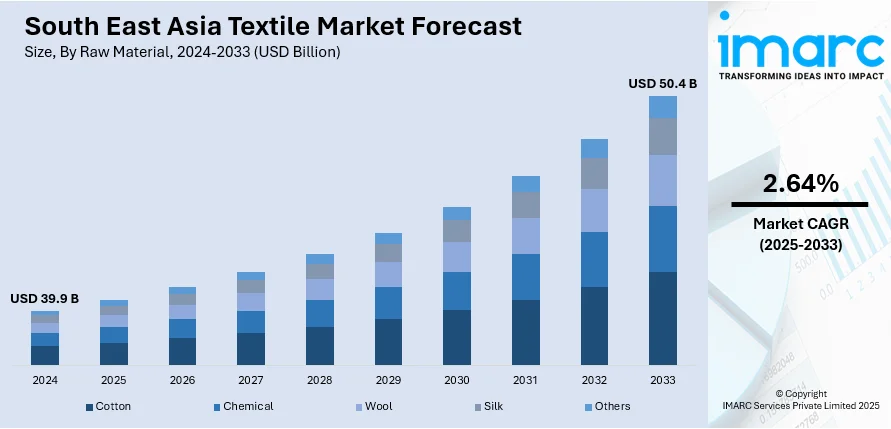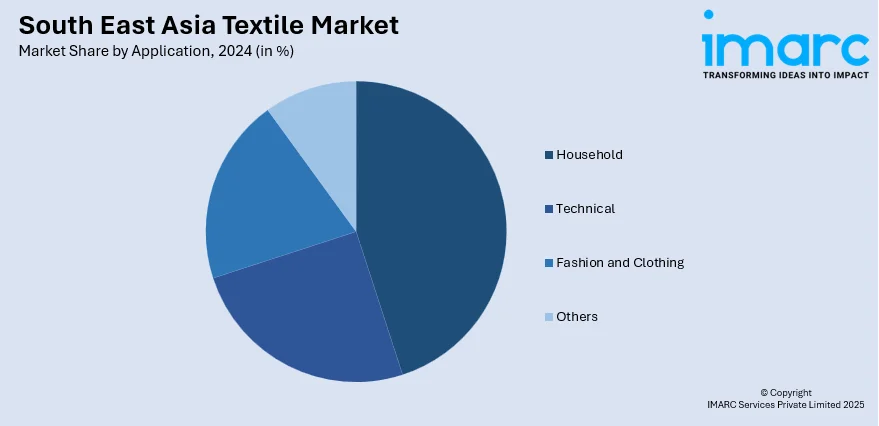
South East Asia Textile Market Size, Share, Trends and Forecast by Raw Material, Product, Application, and Country, 2025-2033
Market Overview:
South East Asia textile market size reached USD 39.9 Billion in 2024. Looking forward, IMARC Group expects the market to reach USD 50.4 Billion by 2033, exhibiting a growth rate (CAGR) of 2.64% during 2025-2033. The growing use of 3D printing and automated knitting, rising demand for personalized and unique products, and increasing need for personalized and unique products represent some of the key factors driving the market.
|
Report Attribute
|
Key Statistics
|
|---|---|
|
Base Year
|
2024
|
|
Forecast Years
|
2025-2033
|
|
Historical Years
|
2019-2024
|
| Market Size in 2024 | USD 39.9 Billion |
| Market Forecast in 2033 | USD 50.4 Billion |
| Market Growth Rate 2025-2033 | 2.64% |
Textile is made by weaving, knitting, crocheting, knotting, tatting, felting, or braiding natural or artificial fibers (yarn or thread). It also includes asbestos and glass fiber, which are derived from mineral sources. It consists of synthetic textiles made from synthetic fibers like polyester, nylon, and acrylic, which are products of chemical processes. It is durable and can withstand wear, pressure, or damage. It also offers comfort, often determined by breathability, softness, and hypoallergenic properties. It is often dyed or printed to add color and patterns and often integrated with various treatments to enhance its properties, like water resistance, shrink resistance, fire retardancy, or to impart anti-wrinkle properties. It has enhanced visual appeal, which is influenced by the color, texture, and pattern. It also holds cultural significance in many societies, often symbolizing traditions, heritage, and artistry. It is available as antimicrobial and hypoallergenic textiles, which contribute to health and hygiene, especially in medical settings. It is used in household items like bedding and curtains, in industrial products like conveyor belts and filtration materials, and in high-tech applications, such as geotextiles for civil engineering.

To get more information on this market, Request Sample
South East Asia Textile Market Trends:
At present, increasing innovations in textile manufacturing, such as 3D printing and automated knitting, to streamline the production process, reduce labor costs, and improve efficiency represent one of the crucial factors impelling the growth of the market in South East Asia. Digital printing on textiles is also emerging as a trend, enabling customization and flexibility in design without the high costs associated with traditional printing methods. These technological advances are assisting manufacturers to meet the growing demand for high-quality, innovative products. Besides this, the rising demand for personalized and unique textile products, driven by the rise of individualism in fashion and interior design is contributing to the market growth in the region. The proliferation of online retail is making a broad range of textile products more accessible to individuals, influencing purchasing patterns. People are also becoming more conscious of the ethical aspects of their purchases, seeking products that are sustainably produced and ethically sourced. In addition, the growing popularity of smart textiles, which incorporate technology to provide added functionality, such as temperature control or health monitoring, is offering a favorable market outlook in the region. Apart from this, key market players are focusing on maintaining supply chain efficiency as it is crucial for preventing trade disputes and disruptions. Additionally, the rising demand for textiles with trendy patterns and prints for affordable prices in the fast fashion industry to manufacture a wide variety of clothing items is bolstering the market growth in the region.
South East Asia Textile Market Segmentation:
IMARC Group provides an analysis of the key trends in each segment of the market, along with forecasts at the regional and country level for 2025-2033. Our report has categorized the market based on raw material, product, and application.
Raw Material Insights:
- Cotton
- Chemical
- Wool
- Silk
- Others
The report has provided a detailed breakup and analysis of the market based on raw material. This includes cotton, chemical, wool, silk, and others.
Product Insights:
- Natural Fibers
- Polyesters
- Nylon
- Others
A detailed breakup and analysis of the market based on the product have also been provided in the report. This includes natural fibers, polyesters, nylon, and others.
Application Insights:

- Household
- Technical
- Fashion and Clothing
- Others
The report has provided a detailed breakup and analysis of the market based on application. This includes household, technical, fashion and clothing, and others.
Country Insights:
- Indonesia
- Thailand
- Singapore
- Philippines
- Vietnam
- Malaysia
- Others
The report has also provided a comprehensive analysis of all the major regional markets, which include Indonesia, Thailand, Singapore, Philippines, Vietnam, Malaysia, and Others.
Competitive Landscape:
The market research report has also provided a comprehensive analysis of the competitive landscape. Competitive analysis such as market structure, key player positioning, top winning strategies, competitive dashboard, and company evaluation quadrant has been covered in the report. Also, detailed profiles of all major companies have been provided.
South East Asia Textile Market Report Coverage:
| Report Features | Details |
|---|---|
| Base Year of the Analysis | 2024 |
| Historical Period | 2019-2024 |
| Forecast Period | 2025-2033 |
| Units | Billion USD |
| Scope of the Report | Exploration of Historical Trends and Market Outlook, Industry Catalysts and Challenges, Segment-Wise Historical and Future Market Assessment:
|
| Raw Materials Covered | Cotton, Chemical, Wool, Silk, Others |
| Products Covered | Natural Fibers, Polyesters, Nylon, Others |
| Applications Covered | Household, Technical, Fashion and Clothing, Others |
| Countries Covered | Indonesia, Thailand, Singapore, Philippines, Vietnam, Malaysia, Others |
| Customization Scope | 10% Free Customization |
| Post-Sale Analyst Support | 10-12 Weeks |
| Delivery Format | PDF and Excel through Email (We can also provide the editable version of the report in PPT/Word format on special request) |
Key Benefits for Stakeholders:
- IMARC’s industry report offers a comprehensive quantitative analysis of various market segments, historical and current market trends, market forecasts, and dynamics of the South East Asia textile market from 2019-2033.
- The research report provides the latest information the market drivers, challenges, and opportunities in the South East Asia textile market.
- Porter's five forces analysis assist stakeholders in assessing the impact of new entrants, competitive rivalry, supplier power, buyer power, and the threat of substitution. It helps stakeholders to analyze the level of competition within the South East Asia textile industry and its attractiveness.
- A competitive landscape allows stakeholders to understand their competitive environment and provides an insight into the current positions of key players in the market.
Key Questions Answered in This Report
The textile market in South East Asia was valued at USD 39.9 Billion in 2024.
The South East Asia textile market is projected to exhibit a CAGR of 2.64% during 2025-2033, reaching a value of USD 50.4 Billion by 2033.
Key factors driving the South East Asia textile market include increasing disposable incomes in emerging economies in the region, rising demand for fashion and apparel, advancements in textile manufacturing technology, and a growing focus on sustainable and eco-friendly materials. Additionally, the region's strong export capabilities and competitive labor costs contribute significantly to market growth.
Need more help?
- Speak to our experienced analysts for insights on the current market scenarios.
- Include additional segments and countries to customize the report as per your requirement.
- Gain an unparalleled competitive advantage in your domain by understanding how to utilize the report and positively impacting your operations and revenue.
- For further assistance, please connect with our analysts.
 Request Customization
Request Customization
 Speak to an Analyst
Speak to an Analyst
 Request Brochure
Request Brochure
 Inquire Before Buying
Inquire Before Buying




.webp)




.webp)












